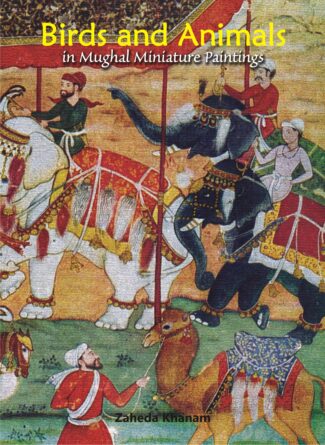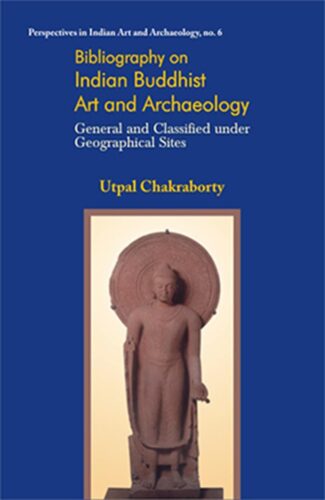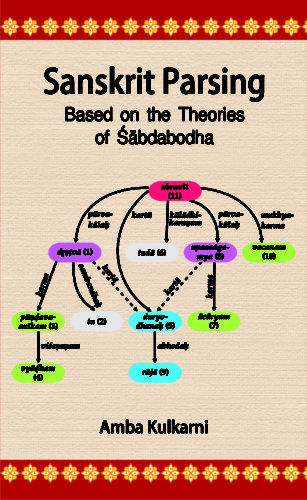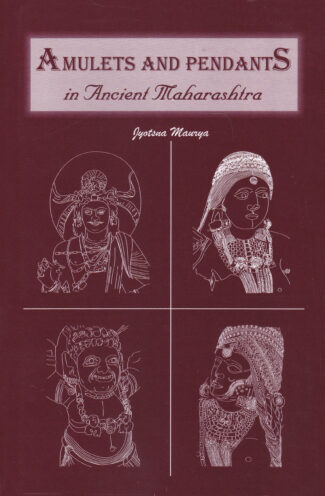

Torana in Indian and...
Torana in Indian and Southeast Asian Architecture
by: Parul Pandya DharThe book details the significance of the toranas arched portals or festoons in ancient and medieval architecture of South and South-east Asia, with special emphasis on Indian representation. The text is richly illustrated with photographs and line drawings from remote sites, museums and archival collections.
Original price was: ₹4,200.00.₹3,780.00Current price is: ₹3,780.00.
ISBN: 9788124605349
Year Of Publication: 2010
Edition: 1st
Pages : xviii, 317
Bibliographic Details : Profusely illustrated; Complete book on art paper; Appendices; Glossary; Bibliography; Index
Size : 31
Language : English
Binding : Hardcover
Publisher: D.K. Printworld Pvt. Ltd.
Size: 31
Weight: 2800
The present work discusses in depth the subject of toraªas (arched portals or festoons) in the ancient and medieval architecture of South- and South-east Asia, with special emphasis on Indian representations. Their antiquity and rationale; their continued presence in association with stupas, caves, temples, mosques, cities, forts, and palaces; their myriad forms and transformations; and their aesthetic and symbolic relationship to the structure in question are analyzed stage-by-stage in this book. The rich corpus of toraªas included here has been critically and comparatively analyzed in relation to traditional practice, as well as in the light of the medieval architectural treatises, historical records, and other literary sources. The approach is micro in the sense of being focused on a specific architectural element but macro in its regional and temporal span. In addition, the exposition reveals the grammar as well as the manifold visual formulations of the toraªa as representative of the basic principles of traditional Indian architectural ornament: integral to the structure, functionally apt, aesthetically significant, and visually evocative, with sound and sophisticated design principles. The text is richly illustrated, bringing together material scattered over several well-known as well as remote sites, museums, and archival collections. Whereas a major part of this book details the journey of the toraªa in ancient and medieval India, the section on early beginnings also includes references from Pakistan and Afghanistan, and the final chapter surveys, with a view to compare, parallel yet distinct expressions in Cambodia, Thailand, Champa, Indonesia, Myanmar, Nepal, and Sri Lanka.
Acknowledgements
Foreword
Contents
Abbreviations
List of Figures
List of Plates
List of Illustrations
1. Introduction
Scope of the work (1);
Semantic Concerns ( );
The Approach ( );
References ( ).
2. Early Beginnings
Early Extant Instances ( );
Fragments and Inscriptions ( );
The North-western Region: Begram, Sirkap, Butkara;
The Western Deccan Region: Pitalkhora, Nasik;
The Eastern Deccan: Amaravati; Eastern India;
Early Literary Sources;
Free-standing Toranas: c. ce 300-500
References.
3. Torana in the Treatises
Critical Interpretation of treatises; Meaning of the term; Role and Purpose; Architectural Setting; The Formal Types;
Sculptural Embellishment & Material; Measurements & Proportions; References.
4. Southern Representations: Maharashtra, Karnataka, Andhra Pradesh & Tamil Nadu
Maharashtra (ca. fifth to seventh century): (Ajanta, Jogeshvari, Magathana, Kanheri, Ellora (Pre-Rashtrakuta Phase);
Karnataka & Andhra Pradesh (ca. seventh & eighth centuries): (Badami, Aihole, Sandur, Pattadakal, Undavalli, Kudaveli Sangameshvara);
Maharashtra: Ellora (Rashtrakuta Phase);
The Tamil Region: (ca. seventh & eighth centuries) (Dalavanur, Siyamangalam & Mamallapuram ( ), Kanchipuram ( ));
Karnataka & Andhra Pradesh: (ca. ninth & tenth centuries) (Bhavanasi Sangam (), Kukkanur, Sirval, Hallur, Aihole, Pattadakal, & Mudhol: Late Reitrakuna Period (), Biccavolu & Chebrolu: Eastern Calukyan (ca. ninth & tenth centuries), Other instances from Calukyan, Ganga, Nolemba, and Shantara territories ( ));
Northern Karnataka & Maharashtra (ca. 10th-13th centuries):Antarla- & dvara-toranas: temple interiors & entrances (Ron, Sudi, Bevur, Kuralgeri, Nagai, Lakkundi, Huli, Kallur, Kuruvatti, Unkal, Hampi (?), Niralagi, Belagavi, Sinnar, Sedam, Hottul, Kalgi, &, Narayanpur);
Southern Karnataka Region: Hoysalas (ca. 11th to 13th centuries):Antarala- & dvara-toranas (Belur & Halebidu);
Karnataka: Kudya-toranas (wall toranas): (ca. 10th-13th centuries) (Lakkundi, Kuruvatti, Dambal, & Ittagi);
Karnataka: Nasi-toranas (wall toranas): (ca. 10th-13th centuries) (Annigeri, & Ittagi);
The Andhra Region: (ca. 11th-13th centuries) (Panagal, Hanamkonda & Warangal);
Tamil Nadu & other Southern Regions: Patra-toranas (ca. 9th-12thcenturies) Vijayanarayanam, Tirupattur, Tirunelveli, Melapalluvur, Kuruvitturai, Kambadahalli, and Hottul;
The Tamil Region: Citra- & Ratna-toranas: (ca. 9th-12th centuries) (Kumbhakonam, Lalgudi, Srinivasanallur, Tiruverumbur, Tirumiyaccur, Pudukottai, Kilaiyur, & Thanjavur);
Later Southern Indian Toranas (post-13th century);
Free-standing Toranas: (Ittagi, Aihole, Alampur, Warangal, Ainavolu, & Hampi);
Notes & References.
5. Western, Central, & Eastern IndianToranas
Western & Central India
General Characteristics; Early Representations: (ca. sixth to ninth centuries) (Tala, Sirpur, Ghumli, Rampol, Chittorgarh, Abaneri, Karvana, & Deogarh);
Ca. 10th century: Kaleshvari-ni-nal, Nagda, Vadhvan, Kakoni, Khajuraho, Ghanerav, Gyaraspur, Atru, Harshagiri, Badoli, Kiradu, & Gurgi;
Ca. 11th-12th centuries:Illika-toranas: Khajuraho, Panna, Kiradu, Modhera, Kumbhariya, Mount Abu, Girnar, Delmal, Asoda, Vadnagar, & Siddhpur;
Andola-toranas: Khor, Jhalarapatan, Bijolia, Deogarh, Modhera, Kumbhariya, Mount Abu, Jhadoli;
Ca. 13th century: Luna Vasahi, Mount Abu;
Free-standing Toranas (ca. ninth-tenth centuries):
Central India: Badoh, Gyaraspur, Terahi, Gurgi;
Rajasthan: Medta-Phalodi, Harshagiri, Badoli, Nagda;
Gujarat: Shamalaji;
Free-standing Toranas (ca. 11th century and later): Osian, Modhera, Mount Abu, Chandravati, Delmal, Menal, Lodrava, Siddhpur, Vadnagar, Asoda, Piludra, Kapadvanj, Some other instances
(Deogarh, Prabhas Patan, Ghumli, Somnath, Ratanpur, Lodrava, Jaisalmer, Abhapur, Darol, Amber);
Pratoli-toranas: Jhinjhuvada, Dabhoi, Mandhata, Junagarh, Gwalior;
Later Developments:Toranas in Indo-Islamic monuments & medieval secular structures; Toranas on later temples; Later illika-toranas;
Eastern Indian Representations
Free-standing Instances: Bodhgaya, Bhubaneshvara;
Engaged toranas on temple walls;
Depictions in sculpture and painting;
Notes & References.
6. South-east & South Asian Parallels
Terminological Concerns;
Cambodia: The Sambor Prei Kuk Style; The Prei Kmeng Style; The Kompong Preah Style; Later Styles; Comaparative references to Indian & Cambodian toranas;
Thailand: Khmer types in Thailand;
Champa: Type 1 (Mi Son E 1); Type 2 (Hoa Lai, Dong Duong, Khuong My); Type 3 (Mi Son A 1); Type 4 (Duong Long);
Indonesia: The Central Javanese Candis: Architectural setting of the toranas; Kalamukha on Javanese toranas; Chronology and Links with India; Central Javanese Kala-makara-toranas: Stylistic affiliations with India Rectangular & Inverted U-shaped variant, The Candi Kalasan (gavaksha) variant, The bow-shaped (capakara) variant, Parikaratoranas;
The pointed arch variant; Eastern Javanese style;
Some South Asian Parallels: Myanmar; Nepal; Sri Lanka;
Notes & References.
7. Overview
Appendix 1: Inscriptional Notices
Appendix 2: References from Literary Sources;
Appendix 3: References in the Treatises;
Glossary
Bibliography: Primary Sources; Secondary Sources.








